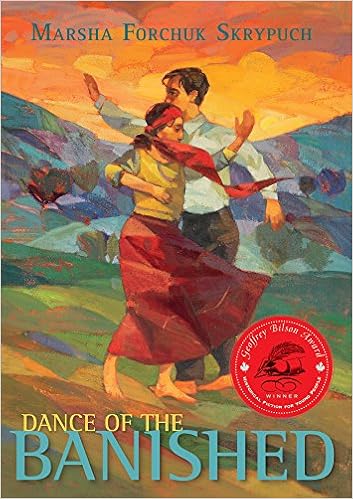In this edition of Knyzka Corner, we will be discussing Marsha Forchuk Skrypuch’s new novel, Dance of the Banished.
Dance of the Banished explores the tragic history of Canadian internment camps and the Armenian genocide. It is a story of injustice, prejudice and violence. Skrypuch’s novel is loosely based on actual events, and it was published to commemorate the 100th anniversary of Canada’s World War I War Measures Act which set up the internment camps. This novel describes the unbreakable bonds of love in the face of catastrophic conflict.
The year is 1913. Teenage lovers Ali and Zeynep live in Eyolmez, Anatolia which is now in Turkey. They are Alevi Kurds who speak the Zaza dialect and practise a religion which believes “in Jesus, the sun, the moon, the stars and Allah.” (p. 16) One key aspect of their religion is a prayer dance called the semah which is the basis for the book’s title, Dance of the Banished.
Ali gets a rare opportunity to immigrate to Canada with his brother Yousef. He cannot afford to bring Zeynep with him but promises to do so in the future. They agree to write letters to each other in their journals. However, their communication soon breaks down as the world is torn apart by war. Zeynep is angry that Ali has left her behind. She must rely on herself to stay alive and find a way to reunite with her beloved Ali. She befriends a group of American Protestant missionaries travelling to the city of Harput where she hopes to work and get an education.
Meanwhile, Ali has been arrested in Brantford, Ontario for being an enemy alien along with 99 other Alevi Kurds. He is sent to an internment camp in Kapuskasing, Ontario where all his belongings are destroyed. He must live in terrible conditions in the frigid Canadian wilderness clearing trees for bunkhouses. Will Ali and Zeynep ever be reunited?
In Dance of the Banished, Skrypuch explores the impact of war on the lives of young people. Zeynep’s courage is exemplified by her determination to help her persecuted Armenian neighbours. She even takes the place of one of her Armenian friends who is being sent away by Turkish soldiers. “Besides, what was the physical difference between an Armenian and an Alevi Kurdish girl?” (p. 167) The Armenian genocide of 1915 resulted in the death of more than one million people.
Skrypuch describes little known historical atrocities so that they are not forgotten. Ali’s treatment in the Canadian internment camp in Kapuskasing is a good example of this. Skrypuch’s own grandfather was interned in Jasper, Alberta. In the “Author’s Note,” there is interesting information about the 24 Canadian internment camps which held “enemy aliens” during World War I, including many Ukrainians. While researching this book, she discovered that 100 Alevi Kurds were taken away from her home town of Brantford to internment camps during World War I.
Marsha Forchuk Skrypuch has received numerous awards and honours for her picture books and young adult novels. She has published three other young adult novels about the Armenian Genocide: The Hunger, Nobody’s Child and Daughter of War. She has also published two junior novels on this topic: Aram’s Choice and Call Me Aram. In 2008, Marsha was awarded the Order of Princess Olha by the president of Ukraine in recognition of the picture book, Enough, which described the Holodomor. Marsha’s novel Making Bombs for Hitler won the Silver Birch Award in 2012 and was on the 2014 shortlist for the Kobzar Literary Award. Her non-fiction work One Step at a Time: A Vietnamese Child Finds Her Way won the 2014 Silver Birch Non-Fiction Award. In Dance of the Banished, readers will discover, “What a terrible world this is, when human beings are treated like garbage.” (p. 175)
Dance of the Banished is available at Chapters and Amazon.
-Written and narrated by Myra Junyk

(Affiliate link. Using this link to purchase will help to support this program, at no extra cost to you.)


